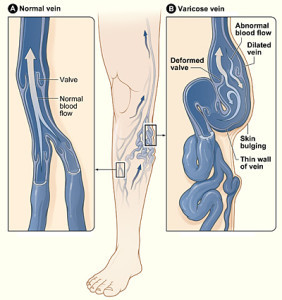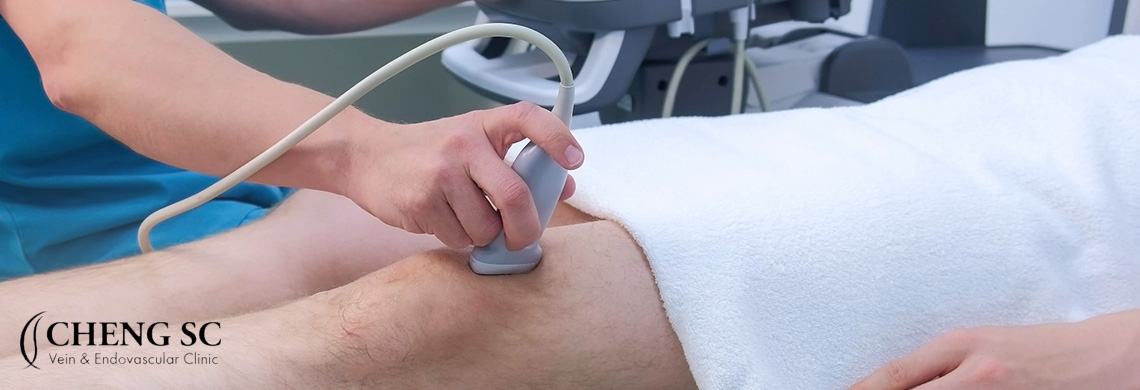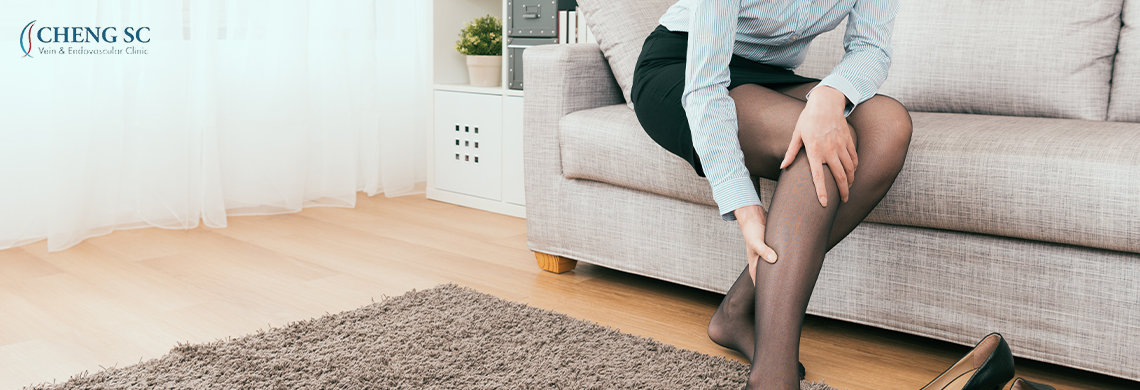 What are Varicose Veins?
What are Varicose Veins?
Varicose veins are unusually enlarged blood vessels near the surface of the skin, most commonly found in the legs, behind your knees and linking all the way to your ankles. Although varicose veins might seem like an aesthetic concern, they can be painful and uncomfortable for some people.
Moreover, this condition may be a symptom of more serious venous diseases such as chronic venous insufficiency. With the technological advancement in medicine, there are many types of minimally invasive varicose vein treatments in Singapore such as ClariVein and VenaSeal which have shown good results.
Ultimately, different individuals have different needs and preferences. As such, the varicose vein treatment recommended to you by your doctor in Singapore will depend on the severity of your condition.
What causes Varicose Veins?
Varicose veins are a result of the failure of the valves in the veins in the legs. In healthy veins, valves in the vein work against gravity to enable blood to flow to the heart for purification. In the case of patients with varicose veins, increased pressure from standing too long causes the valves to not work properly, resulting in the blood flowing backwards and collecting in the vein. Blood that pools causes the vein to enlarge and become twisted, leading to varicose veins.
Medical findings show that varicoses occur in 35% of women and 20% of men over the age of 20. Women are more likely to suffer from the condition as a result of hormonal changes weakening the veins during pregnancy or menopause. Varicose veins often run in families with genetic predisposition where some patients are born with faulty valves from childbirth. Ageing and being overweight also increases the risk of acquiring the condition.
Symptoms of Varicose Veins
Some people do not experience any pain or discomfort. Mild symptoms of varicose veins may include:
- Veins that are dark purple or blue in colour.
- Veins that appear visible, twisted and swollen.
- Aching and cramps in the leg
- Itchiness near the area of the veins and swelling in your feet and ankles.
More serious and painful symptoms of varicose veins may include:
- Burning, throbbing, muscle cramping and swelling in your legs.
- Aggravated pain after sitting or standing for a long period of time.
- Leg ulcers, which may indicate you have a serious type of vascular ailment that requires health care attention.
- Open Sores and bleeding
How To Prevent Varicose Veins?
Varicose veins is a common condition characterised by swollen, twisted veins, often seen in the legs. While certain factors such as genetics and ageing can increase the risk of developing varicose veins, there are proactive steps you can take to help prevent their occurrence or minimise their progression.
- Regular Exercise: Engage in regular physical activity to promote good circulation and muscle tone. Activities such as walking, swimming, and cycling can help strengthen the calf muscles, which play a crucial role in assisting blood flow in the legs.
- Maintain a Healthy Weight: Excess body weight can put added pressure on the veins in your legs. Maintaining a healthy weight through a balanced diet and exercise can help alleviate this pressure and reduce the risk of varicose veins.
- Elevate Your Legs: Whenever possible, elevate your legs above heart level to encourage blood flow back to the heart. This is particularly important after prolonged periods of sitting or standing.
- Avoid Prolonged Sitting or Standing: If your job requires long periods of sitting or standing, take regular breaks to move and stretch your legs. Shift your weight from one leg to another or do calf raises to help prevent blood from pooling in the lower extremities.
- Wear Compression Stockings: Consider wearing compression stockings, especially if you have a family history of varicose veins or experience symptoms like leg fatigue or swelling. These stockings help improve blood flow by providing gentle pressure to the legs.
Diagnosis of Varicose Veins
During the diagnosis of varicose veins, our vascular specialist will do a physical exam to check for swelling, sores, skin colour changes or tender areas in your legs while you are standing or sitting with your legs dangling. Our doctor may also ask you to describe any cases of pain and discomfort in your legs over the years to diagnose varicose veins.
If you have signs of deep vein thrombosis or abnormal blood flows, our doctor may do a Sonography (vascular ultrasound test) to examine if your blood is flowing normally or if there is any evidence of a blood clot within the varicose veins. Our doctor is among the few vascular surgeons in Singapore trained to do this non-invasive test. With his ability to do an ultrasound and understand the information in the same consultation, our doctor can quickly diagnose and recommend customised procedures to prevent the worsening of varicose veins.
Should I seek treatment for Varicose Veins?
This condition is not just a cosmetic issue, without treatment, it can lead to other medical complications. There are several reasons why you should make an appointment and seek treatment for your varicose veins from medical centres.
Discomfort and Aches: There may be no symptoms associated with this condition in the initial stages. As varicose veins become more severe, you will start to experience major discomforts such as aches, cramps and swelling and affect your quality of life.
Progressive Disease: Varicose veins will NOT recede with self-care remedies. While compression stockings, medication, cream and leg elevation will alleviate the symptoms and prevent the condition from getting worse, these treatments will not cure the disease or remove the unsightly veins.
Leg Ulceration: If you see any skin colour changes around the ankle, it can be a sign that your varicose veins are rather serious and there is a substantial risk that it may become leg ulceration. When this happens, if patients get cuts and/or wounds, these wounds do not heal up, progressing to become leg ulcers or gangrene and may end up getting infected resulting in surgical amputations.
The latest Treatment, Clarivein, is minimally invasive: In the past, the treatment of varicose veins involved major invasive surgery to strip your affected veins that take weeks to recover. Technology has advanced to effective treatments for varicose veins where you could come into the vein clinic, have the procedure performed under local anaesthesia and leave 1 hour later to go about your normal activities. The advantages of this treatment are no bruises, no scars, no general anaesthesia and no hospitalization needed.
Covered by medical insurance: If you have medical insurance, varicose veins should be a medical condition covered by your insurance.
Varicose Veins Treatment in Singapore
The choice of treatment will depend on the severity and location of the varicose veins, as well as your overall health and preferences. We will assess your condition and recommend the most appropriate treatment option.
-
Endovenous Laser Ablation (EVLA) or Radiofrequency Ablation (RFA):
These minimally invasive procedures use heat generated by laser or radiofrequency energy to seal off and collapse the affected vein. This causes the blood to reroute through healthier veins, reducing the appearance and symptoms of varicose veins.
-
Sclerotherapy:
Sclerotherapy involves injecting a special solution directly into the varicose vein. The solution irritates the vein’s lining, causing it to collapse and eventually be absorbed by the body. This is often used for smaller varicose veins and spider veins.
-
Vein Stripping and Ligation:
In cases of severe varicose veins, surgical procedures like vein stripping and ligation may be recommended. During vein stripping, the affected vein is surgically removed, while ligation involves tying off the vein to prevent blood flow. These procedures are typically performed under anaesthesia.
-
Compression Stockings:
While not a direct treatment for varicose veins, compression stockings are often recommended as part of a conservative management approach. They help improve blood circulation in the legs and reduce symptoms like swelling and discomfort associated with varicose veins.
Related Posts
Frequently Asked Questions
Varicose veins can be caused by occupational and lifestyle factors including prolonged standing.
Varicose veins can be treated through several treatment options such as sclerotherapy, radiofrequency and tissue glue. Fortunately, these are minimally invasive.
It is highly recommended to visit a vein clinic when you experience severe and continuous pain, swelling in the legs, bleeding, ulcer infection and skin infection. Ideally, you should treat your varicose veins before these symptoms start to appear.
No. Varicose veins do not go away unless proper treatment is provided.
While no particular food negatively impacts varicose veins, they cannot be treated by dietary changes either. Therefore, it is still highly recommended to visit a vein clinic for treatment.
Varicose veins are not a sign of poor health. However, if left untreated they can bleed and clot up, causing ulcers and permanent skin damage.




